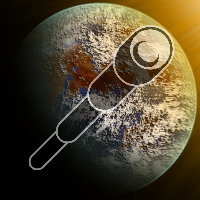Hemera
The Jewel of Ophiuchus
Hemera is one of eleven planets orbiting Barnard's Star (called Helios locally), and a vital link in the interstellar transport network. Though tidally locked, Hemera has an extremely active magnetosphere and oceans of liquid water, and the atmosphere is a fairly Earthlike mix of nitrogen and oxygen. Although Helios occasionally experiences solar flares, Hemera’s powerful magnetosphere protects its surface from the worst of the solar radiation.
Hemera has endemic complex life (the most visually notable being the vibrant red plants), as well as the ruins of an ancient civilization. At one point, Hemera bore an indigenous sophont species called the skgri'i, who were driven to extinction by civil war after two millennia of interstellar expansion.
Geography
Location
Hemera is the second planet from its sun, Helios. It has a single natural satellite –a large and close-orbiting asteroid called Cephalus– and millions of artificial satellites.Surface
Landmasses
Hemera has three large continents that are diverging remarkably slowly, even on a geological scale. The southwestern continent, Hesperia, bears forests over much of its seaward landmass, transitioning to tundra and cold desert near the terminator line. The southeastern continent, Mesimeria, consists predominantly of lowland forest and swamp, surrounding the eroded steppes of the Aither Plateau. The northeastern continent, Eosphoria, is mostly cold desert, with a thick stripe of of sprawling grasslands and low, hammocked hills toward the coast. Hemera still bears the scars of its ancient war in the form of craters that litter the surface, caused by the impact of orbital kinetic weapons. Interstellar warfare is a horrifying prospect, and Hemera was fortunate enough to keep its biosphere intact; several other skgri worlds experienced mass extinctions or complete sterilization.Watershed
Hemera is a rather dry world thanks to the immense ice cap that blankets the antisolar hemisphere, but it still holds appreciable quantities of surface water. This water is mostly contained within the somewhat shallow global ocean, with fresh water accumulating in ancient glacial valleys and occasionally flowing out to meet the sea. This ocean is divided, on the solar side, into two large seas: the larger northern Protean Sea and the smaller southern Thalassan Sea. In addition to these, the continental divide between Mesimeria and Eosphoria has produced a much smaller, younger sea fed by the subglacial ocean: the Stilbon Sea.Solar Cyclone
Hemera's solar hemisphere is, like most other tidally locked worlds, dominated by a monstrous permanent cyclonic storm. The Maelstrom, as Hemerans have dubbed it, is the result of intense oceanic and atmospheric heating near the subsolar point of the planet, and as a result its powerful winds distribute moisture back towards the terminator and even out the extreme temperature gradient that Hemera experiences due to its tidal locking.Ecosystem
Hemera was the abiogenetic origin point of the Hemeragenia group, which is the most ancient documented tree of life in known space at ten billion years old and still thrives across its sunward surface to this day. Up until roughly ten thousand years ago, Hemera's planetary ecology included a sapient species known as the skgri'i, but they have since gone extinct. While Hemeragenid biochemistry shares many similarities common to most genesis groups, there are some key differences. One of these is the usage of phycoerythrin and some carotenoids for photosynthesis, instead of the more familiar chlorophylls, making Hemeran plants appear red.Hemeragenid Life
Chemistry
- Hydrogen
- Oxygen
- Nitrogen
- Phosphorous
- Sulfur
Genetics
- Adenine
- Cytosine
- Guanine
- Thymine
Metabolics
- Nicotinamide reversible hydrogen ionization
- Acetyl enzyme oxidation
Structure
Base unit is a phospholipid bilayer cell with internal components in water-based fluid suspension. Genetic material is contained within the cell either in open suspension or within a specialized chamber.Geopolitics
The habitable landmass of Hemera is claimed by three major political organizations, arranged along continental lines. The Hesperian Confederacy is an association of smaller states across the continent of Hesperia; the Twilight Republic governs the continent of Mesimeria; and the Eosphorian Commonwealth is the organizing body for the states and territories of the continent of Eosphoria. All three of these polities convene under the United Nations of Hemera to arbitrate shared governance of the rest of the planet and its orbital space, including its moon Cephalus.Maps
-
Hemera
Hemera is a terra-class planet in the Barnard's Star system, being the former homeworld of the skgri'i and a current human-inhabited world.
Archive Data
HAZARDS
- Cephalus (asteroid)
- 62.8% nitrogen
- 36.5% oxygen
- 0.7% other gases
Reality Check
OLD INFOWhile Hemera as presented here does not exist, recent analysis of CARMENES data suggests that Barnard's Star has a contingent of several planets, one of which may be a rocky planet of about 0.4 Earth masses orbiting every 8.13 Earth days. If this result is confirmed, it would mark the first time that a planet I created for Astra Planeta predicted the existence of a real planet with uncanny precision.









This looks so cool! What program did you use for the map?
Thank you! The maps in the Diaspora are all made using the planet editor in SpaceEngine, and tweaked further in Paint.NET.